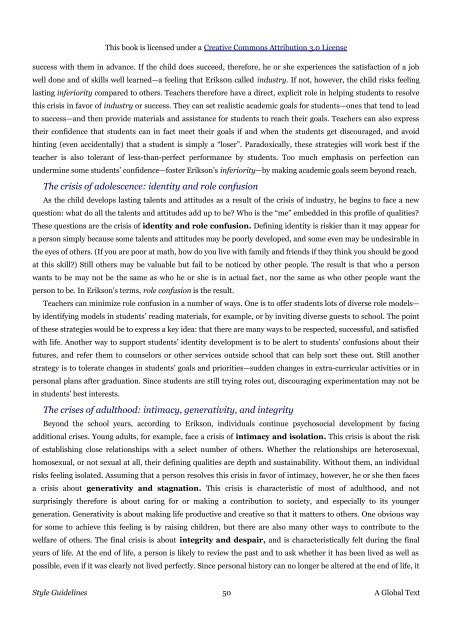Educational Psychology Third Edition Kelvin Seifert and Rosemary ...
Educational Psychology Third Edition Kelvin Seifert and Rosemary ...
Educational Psychology Third Edition Kelvin Seifert and Rosemary ...
Create successful ePaper yourself
Turn your PDF publications into a flip-book with our unique Google optimized e-Paper software.
This book is licensed under a Creative Commons Attribution 3.0 License<br />
success with them in advance. If the child does succeed, therefore, he or she experiences the satisfaction of a job<br />
well done <strong>and</strong> of skills well learned—a feeling that Eriks0n called industry. If not, however, the child risks feeling<br />
lasting inferiority compared to others. Teachers therefore have a direct, explicit role in helping students to resolve<br />
this crisis in favor of industry or success. They can set realistic academic goals for students—ones that tend to lead<br />
to success—<strong>and</strong> then provide materials <strong>and</strong> assistance for students to reach their goals. Teachers can also express<br />
their confidence that students can in fact meet their goals if <strong>and</strong> when the students get discouraged, <strong>and</strong> avoid<br />
hinting (even accidentally) that a student is simply a “loser”. Paradoxically, these strategies will work best if the<br />
teacher is also tolerant of less-than-perfect performance by students. Too much emphasis on perfection can<br />
undermine some students’ confidence—foster Erikson’s inferiority—by making academic goals seem beyond reach.<br />
The crisis of adolescence: identity <strong>and</strong> role confusion<br />
As the child develops lasting talents <strong>and</strong> attitudes as a result of the crisis of industry, he begins to face a new<br />
question: what do all the talents <strong>and</strong> attitudes add up to be? Who is the “me” embedded in this profile of qualities?<br />
These questions are the crisis of identity <strong>and</strong> role confusion. Defining identity is riskier than it may appear for<br />
a person simply because some talents <strong>and</strong> attitudes may be poorly developed, <strong>and</strong> some even may be undesirable in<br />
the eyes of others. (If you are poor at math, how do you live with family <strong>and</strong> friends if they think you should be good<br />
at this skill?) Still others may be valuable but fail to be noticed by other people. The result is that who a person<br />
wants to be may not be the same as who he or she is in actual fact, nor the same as who other people want the<br />
person to be. In Erikson's terms, role confusion is the result.<br />
Teachers can minimize role confusion in a number of ways. One is to offer students lots of diverse role models—<br />
by identifying models in students’ reading materials, for example, or by inviting diverse guests to school. The point<br />
of these strategies would be to express a key idea: that there are many ways to be respected, successful, <strong>and</strong> satisfied<br />
with life. Another way to support students’ identity development is to be alert to students’ confusions about their<br />
futures, <strong>and</strong> refer them to counselors or other services outside school that can help sort these out. Still another<br />
strategy is to tolerate changes in students’ goals <strong>and</strong> priorities—sudden changes in extra-curricular activities or in<br />
personal plans after graduation. Since students are still trying roles out, discouraging experimentation may not be<br />
in students’ best interests.<br />
The crises of adulthood: intimacy, generativity, <strong>and</strong> integrity<br />
Beyond the school years, according to Erikson, individuals continue psychosocial development by facing<br />
additional crises. Young adults, for example, face a crisis of intimacy <strong>and</strong> isolation. This crisis is about the risk<br />
of establishing close relationships with a select number of others. Whether the relationships are heterosexual,<br />
homosexual, or not sexual at all, their defining qualities are depth <strong>and</strong> sustainability. Without them, an individual<br />
risks feeling isolated. Assuming that a person resolves this crisis in favor of intimacy, however, he or she then faces<br />
a crisis about generativity <strong>and</strong> stagnation. This crisis is characteristic of most of adulthood, <strong>and</strong> not<br />
surprisingly therefore is about caring for or making a contribution to society, <strong>and</strong> especially to its younger<br />
generation. Generativity is about making life productive <strong>and</strong> creative so that it matters to others. One obvious way<br />
for some to achieve this feeling is by raising children, but there are also many other ways to contribute to the<br />
welfare of others. The final crisis is about integrity <strong>and</strong> despair, <strong>and</strong> is characteristically felt during the final<br />
years of life. At the end of life, a person is likely to review the past <strong>and</strong> to ask whether it has been lived as well as<br />
possible, even if it was clearly not lived perfectly. Since personal history can no longer be altered at the end of life, it<br />
Style Guidelines 50 A Global Text


